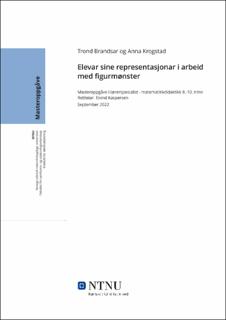| dc.contributor.advisor | Kaspersen, Eivind | |
| dc.contributor.author | Brandsar, Trond | |
| dc.contributor.author | Krogstad, Anna | |
| dc.date.accessioned | 2022-11-29T18:19:12Z | |
| dc.date.available | 2022-11-29T18:19:12Z | |
| dc.date.issued | 2022 | |
| dc.identifier | no.ntnu:inspera:121329407:58160156 | |
| dc.identifier.uri | https://hdl.handle.net/11250/3034860 | |
| dc.description.abstract | Representasjon og kommunikasjon er eitt av seks kjerneelement i den nye læreplanen i matematikk, LK20. Å kunne bruke representasjonar og syne representasjonskompetanse er viktig med tanke på å utvikle elevane si kompetanse i utforsking og problemløysing i matematikk, noko som er ein føresetnad for å førebu elevane på eit samfunn og arbeidsliv i utvikling (Utdanningsdirektoratet, 2022). I denne kvalitative studien har vi sett på korleis ungdomsstegselevar nyttar ulike representasjonar i arbeid med figurmønsteroppgåver. Formålet med prosjektet var å få eit innblikk i kva for repertoar av representasjonar dei hadde, kva for representasjonar som var mest frekvente, og om dei synte representasjonsfleksibilitet. For å finne svar på forskingsspørsmålet har vi vore inne i ei 8. klasse og ei 10. klasse og aktivt observert og teke lydopptak av elevane når dei løyste figurmønsteroppgåver i små grupper.
Vi har hovudsakleg brukt Duval (2006) sitt rammeverk om semiotiske representasjonar som grunnlag for vår deduktive, tematiske analyse. Vi ende opp med fem kategoriar som beskriv representasjonsrepertoaret til elevane. Desse kategoriane samsvarar med Duval (2006) sitt representasjonssystem med unntak av kategorien konkretar som vi valte å sette som ein eigen kategori under dei multifunksjonelle representasjonane.
Forskingsprosjektet vårt var kvalitativt og vi kan derfor ikkje generalisere funna våre, men dei kan gje ein indikasjon på korleis ungdomsskuleelevar bruker representasjonar i samband med figurmønsteroppgåver. Funna våre tyder på at elevane har jobba med ulike representasjonar tidlegare, samt at dei synte at mange av elevane i både 8. og 10. klasse har utvikla breitt repertoar av representasjonar. Det var likevel tydeleg forskjell mellom klassane i representasjonsbruk. 8. klasse held seg mest innan dei multifunksjonelle semiotiske representasjonane, medan 10. klasse nytta både multifunksjonelle og monofunksjonelle representasjonar. | |
| dc.description.abstract | “Representation and communication” is one of six core elements in the new mathematics curriculum, LK20. In order to develop their competence in problem solving, the pupils must meet different representations and develop representational competence. This will also help the students in meeting a developing society and working life (Utdanningsdirektoratet, 2022). In this qualitative study, we have looked at how junior high school students use different representations when working with figure pattern assignments. The purpose of the project was to get an insight into what kind of repertoire of representations they had, what kind of representations were used most frequent and whether they showed representational flexibility. To find answers to the research questions, we have observed 8th and 10th graders who solved figure pattern tasks in small groups.
We have mainly used Duval's (2006) framework on semiotic representations as a basis for our deductive, thematic analysis. We ended up with five categories that describe the representational repertoire of the pupils. These categories correspond to Duval's (2006) representation system. The exception is a category of manipulatives, which we chose to place as a separate category under the multifunctional representations.
Our research project was qualitative, and therefore we cannot generalize our findings. However, they can tell us something about how junior high school students use representations in connection with figure pattern tasks. Our findings indicate that the pupils have previously worked with different representations, and that many of the pupils in both 8th and 10th grade have developed a broad repertoire of representations. There was still a distinct difference between the classes in the use of representations. The 8th graders worked mostly within the multifunctional semiotic representations, while the 10th graders use both multifunctional and monofunctional representations. | |
| dc.language | nno | |
| dc.publisher | NTNU | |
| dc.title | Elevars sine representasjonar i arbeid med figurmønster | |
| dc.type | Master thesis | |
